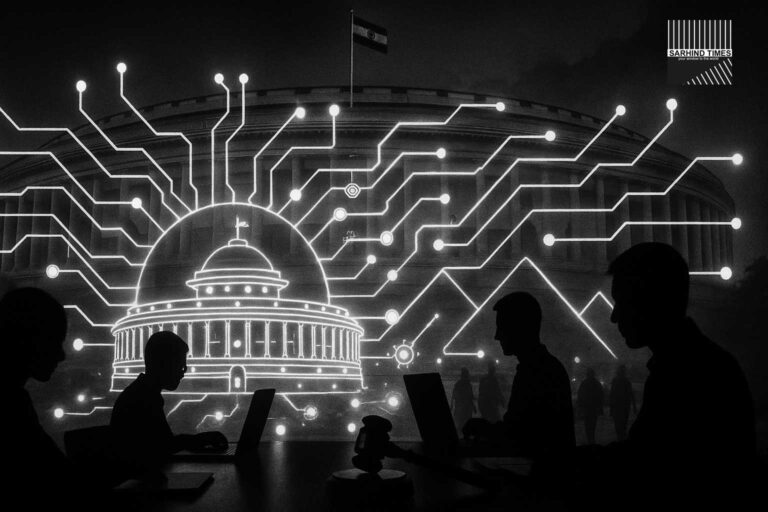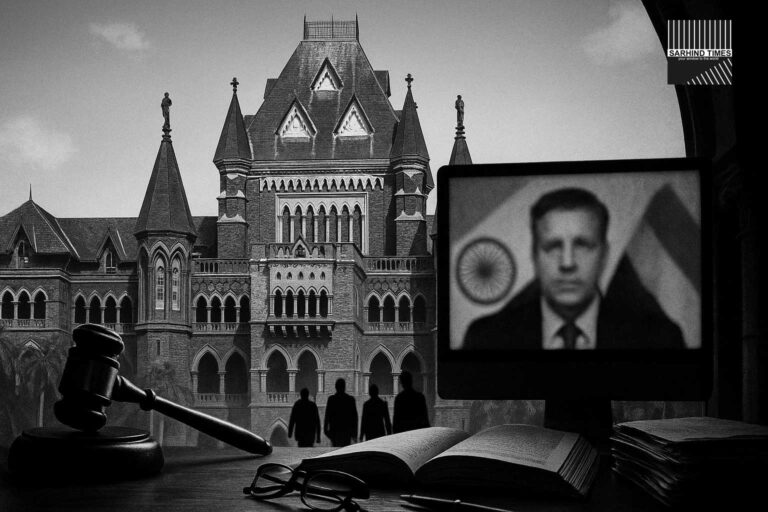India is set to introduce its first comprehensive Artificial Intelligence Regulation Bill in the upcoming winter session of Parliament — a landmark legislation aiming to govern the ethical use of AI across industries. The Bill seeks to balance technological innovation with constitutional accountability, proposing clear frameworks for AI transparency, bias audits, data protection, and algorithmic oversight.
If passed, it will make India one of the first major democracies outside the EU to adopt a national AI law.
New Delhi, October 23 —
India is preparing to step into a new era of digital governance with the introduction of the Artificial Intelligence Regulation Bill, 2025, a long-anticipated legislative framework that aims to make AI “accountable, transparent, and human-centered.”
The proposed Bill — drafted by the Ministry of Electronics and Information Technology (MeitY) in consultation with NITI Aayog and the Law Commission — will be tabled during the winter session of Parliament next month.
“AI is transforming the economy. But transformation must never come without ethics,” said Union IT Minister Ashwini Vaishnaw, announcing the Bill’s introduction.
“India’s approach will be innovation-led but responsibility-driven.”
1. Why an AI Law Now
India’s AI ecosystem has grown rapidly — from digital assistants in smartphones to algorithmic trading, healthcare diagnostics, and government welfare analytics.
Yet, the lack of a legal framework has created risks of:
- Data misuse,
- Algorithmic bias,
- AI-generated misinformation, and
- Autonomous decision-making without oversight.
The AI Regulation Bill aims to address these challenges by introducing binding standards for ethical deployment, especially in finance, healthcare, education, and law enforcement.
“Unregulated AI is like nuclear power without control rods,” said Rajeev Chandrasekhar, Minister of State for IT.
“We are setting guardrails before the explosion of innovation overwhelms ethics.”
2. Structure of the Bill
The draft Bill — a 128-page document — is divided into four key chapters:
- Governance and Oversight
- Establishes a National Artificial Intelligence Authority (NAIA) to regulate, license, and audit AI systems.
- Sets up State AI Councils for local coordination.
- Establishes a National Artificial Intelligence Authority (NAIA) to regulate, license, and audit AI systems.
- Ethical Standards and Risk Classification
- Categorises AI systems as Low-Risk, Medium-Risk, or High-Risk based on potential social impact.
- Mandates bias audits, data traceability, and explainability for all High-Risk AI.
- Categorises AI systems as Low-Risk, Medium-Risk, or High-Risk based on potential social impact.
- Accountability and Redressal
- Introduces “Right to Explanation” — giving citizens the right to understand decisions made by automated systems.
- Requires human oversight in critical decision areas like recruitment, healthcare, finance, and policing.
- Introduces “Right to Explanation” — giving citizens the right to understand decisions made by automated systems.
- Innovation and Sandbox Frameworks
- Encourages AI startups through Regulatory Sandboxes — test zones for experimentation under supervision.
- Offers tax incentives for AI for Public Good projects.
- Encourages AI startups through Regulatory Sandboxes — test zones for experimentation under supervision.
3. Key Principles: India’s AI Ethics Charter
The Bill codifies a set of ethical principles known as the “Five Pillars of Responsible AI”:
- Accountability – Every AI system must have an identifiable human or institutional owner.
- Transparency – Algorithms must be auditable and explainable.
- Safety and Reliability – AI must undergo testing for accuracy and resilience.
- Privacy by Design – All AI systems must comply with the Digital Personal Data Protection (DPDP) Act, 2023.
- Fairness and Inclusivity – AI cannot discriminate based on caste, gender, religion, or geography.
“The AI Bill enshrines human dignity as its core principle,” said Dr. S. Chandrasekhar, NITI Aayog’s AI Advisor.
“It ensures technology serves citizens, not the other way around.”
4. Lessons from the Global Landscape
The Indian framework draws from international models but retains local adaptation:
- The EU’s AI Act (2024) — focuses on high-risk AI regulation.
- The U.S. AI Bill of Rights — defines citizen protection standards.
- The OECD AI Principles — emphasize transparency and accountability.
India’s version integrates these concepts with its unique priorities — inclusion, affordability, and democratic oversight.
“The Indian model recognises diversity as a data point,” noted Dr. Fei-Fei Li, Stanford AI researcher.
“That makes it globally relevant.”
5. Preventing Algorithmic Discrimination
One of the Bill’s most praised provisions is the mandatory bias audit for all major AI systems.
It requires developers to test datasets for prejudice against marginalised groups, publish results publicly, and rectify disparities.
“Bias in data is bias in destiny,” said Justice (Retd.) Deepak Gupta, member of the drafting committee.
“This law demands transparency not just from code, but from conscience.”
6. Protecting Jobs and Human Oversight
The Bill acknowledges public concern over AI-driven job displacement.
It requires every automation project involving more than 500 employees to submit a Human Impact Assessment Report before deployment.
Additionally, critical services such as law enforcement, judiciary, and healthcare must maintain mandatory human oversight over AI systems.
“AI should augment intelligence, not replace integrity,” said Labour Minister Bhupender Yadav.
7. The Role of the National AI Authority (NAIA)
The proposed National Artificial Intelligence Authority will function as an independent statutory regulator — similar to SEBI or TRAI.
Its powers include:
- Registering AI developers and service providers,
- Conducting algorithmic audits,
- Penalising non-compliance (up to ₹50 crore), and
- Maintaining a National AI Registry of certified systems.
“Just as RBI ensures trust in money, NAIA will ensure trust in intelligence,” said MeitY Secretary S. Krishnan.
8. AI and Democracy
Lawmakers across parties have largely welcomed the Bill, but emphasised the need for parliamentary oversight to prevent overreach.
Shashi Tharoor (INC) cautioned that “AI regulation should not become AI restriction.”
Rajeev Ranjan Singh (JD-U) called for citizen representation on the NAIA Board.
Meanwhile, Smriti Irani (BJP) praised the inclusion of ethical certification frameworks for startups.
“The idea is not to slow innovation but to civilise it,” said MP Priyanka Chaturvedi.
9. Data Protection and AI Privacy
The Bill makes direct reference to the DPDP Act, 2023, requiring that all AI systems:
- Seek explicit user consent before processing personal data.
- Offer data deletion and portability options.
- Store sensitive data only on Indian servers unless exempted by the NAIA.
This provision strengthens India’s stance on digital sovereignty, ensuring that citizens’ data isn’t exported without accountability.
10. Deepfakes and AI-Generated Content
The Bill introduces the “Authenticity Mandate”, requiring all AI-generated media to include a digital watermark or disclosure tag.
This aims to combat the surge of deepfakes — synthetic videos and voices used for misinformation and impersonation.
Violations could attract:
- Fines up to ₹25 lakh for individuals,
- Three years of imprisonment for deliberate misuse, and
- Platform liability for failing to flag manipulated content.
“Truth must not be lost in the age of simulation,” said Union I&B Minister Anurag Thakur.
11. Startups and Innovation
To balance compliance with creativity, the Bill establishes AI Innovation Sandboxes where startups can test algorithms under monitored environments before commercial release.
The government will also launch an AI Startup Credit Guarantee Fund worth ₹2,000 crore to encourage ethical entrepreneurship.
“We are regulating to empower, not to intimidate,” said Minister Vaishnaw.
12. Education and Workforce Transformation
Recognising AI’s impact on jobs, the Bill mandates integration of AI literacy in school and university curricula.
The UGC and AICTE will collaborate to launch “AI for Bharat” skill programs across 400 universities.
“AI education is not optional anymore,” said Dharmendra Pradhan, Minister for Education.
“We’re preparing the youth to lead in this new world, not fear it.”
13. Expert Reaction
Policy experts have described the Bill as “balanced and forward-looking.”
Arundhati Bhattacharya, CEO of Salesforce India, called it “the bridge between innovation and integrity.”
However, others caution that implementation capacity may pose challenges, especially for smaller companies.
“Regulation without readiness could backfire,” warned Dr. Ritesh Malik, tech policy researcher.
“We need AI literacy in government before we regulate the private sector.”
14. Opposition View
Some lawmakers argue that overregulation could discourage foreign investment and stifle innovation.
The Confederation of Indian Industry (CII) has urged the government to ensure the law remains “flexible and innovation-friendly.”
“The line between safety and stagnation is thin,” said CII President Sanjiv Bajaj.
“We must walk it wisely.”
15. International Response
The Bill has attracted global attention.
The European Parliament lauded India’s initiative, saying “democratic AI regulation must have voices from the Global South.”
Meanwhile, UNESCO’s AI Ethics Office offered support for establishing joint certification standards.
“India’s Bill could become the template for developing nations,” said Gabriela Ramos, Assistant DG, UNESCO.
16. Parliamentary Timeline
The Bill will be introduced in Lok Sabha next month, followed by review by the Standing Committee on Communications and Information Technology.
A joint consultation with stakeholders from academia, industry, and civil society will precede the final vote expected in February 2026.
If enacted, the law will come into force six months later — allowing time for compliance setup.
17. Enforcement Mechanisms
To ensure accountability, the Bill proposes:
- Annual AI Impact Reports from major platforms.
- Compulsory registration of AI models above 100 billion parameters.
- Algorithmic audit trails to be maintained for 10 years.
Non-compliance could lead to license suspension, penalties up to ₹50 crore, or criminal prosecution for wilful violations.
18. The Public Debate
Social media reactions have been sharply divided — some calling it a “historic safeguard”, others fearing “bureaucratic micromanagement.”
Tech influencers urged for a balance between innovation speed and ethical depth.
“India doesn’t need a pause in AI — it needs purpose,” wrote AI scientist Tanmay Bhatia on X.
“This Bill could give it that.”
19. A Global AI Superpower in the Making
With its vast data ecosystem, skilled talent pool, and emerging startups, India is poised to become a major global AI hub.
Regulation, experts say, is the missing piece to legitimise this leadership.
“AI made in India must mean AI trusted by the world,” said Prime Minister Narendra Modi in a previous statement.
20. Conclusion: The Law of Tomorrow
If the AI Regulation Bill becomes law, India will join a small group of nations charting the ethical frontier of the digital age.
It signals not caution, but confidence — that democracy can innovate responsibly.
“In the machine age, humanity must remain the algorithm’s author,” said Chief Justice D.Y. Chandrachud recently.
“This Bill is India’s declaration that intelligence, natural or artificial, will always serve the Constitution.”
And with that, India stands ready to define what responsible intelligence means — not just for itself, but for the world watching.
#AIBill #ArtificialIntelligence #AIRegulation #Parliament #DigitalIndia #TechPolicy #EthicalAI #SarhindTimes




















+ There are no comments
Add yours